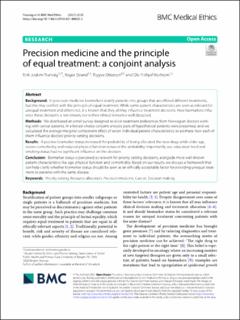| dc.contributor.author | Tranvåg, Eirik Joakim | |
| dc.contributor.author | Strand, Roger | |
| dc.contributor.author | Ottersen, Trygve | |
| dc.contributor.author | Norheim, Ole Frithjof | |
| dc.date.accessioned | 2021-10-07T08:30:32Z | |
| dc.date.available | 2021-10-07T08:30:32Z | |
| dc.date.created | 2021-10-06T13:49:56Z | |
| dc.date.issued | 2021 | |
| dc.identifier.issn | 1472-6939 | |
| dc.identifier.uri | https://hdl.handle.net/11250/2788310 | |
| dc.description.abstract | Background: In precision medicine biomarkers stratify patients into groups that are offered different treatments, but this may conflict with the principle of equal treatment. While some patient characteristics are seen as relevant for unequal treatment and others not, it is known that they all may influence treatment decisions. How biomarkers influence these decisions is not known, nor is their ethical relevance well discussed.
Methods: We distributed an email survey designed to elicit treatment preferences from Norwegian doctors working with cancer patients. In a forced-choice conjoint analysis pairs of hypothetical patients were presented, and we calculated the average marginal component effect of seven individual patient characteristics, to estimate how each of them influence doctors’ priority-setting decisions.
Results: A positive biomarker status increased the probability of being allocated the new drug, while older age, severe comorbidity and reduced physical function reduced the probability. Importantly, sex, education level and smoking status had no significant influence on the decision.
Conclusion: Biomarker status is perceived as relevant for priority setting decisions, alongside more well-known patient characteristics like age, physical function and comorbidity. Based on our results, we discuss a framework that can help clarify whether biomarker status should be seen as an ethically acceptable factor for providing unequal treatment to patients with the same disease. | en_US |
| dc.language.iso | eng | en_US |
| dc.publisher | BMC | en_US |
| dc.rights | Navngivelse 4.0 Internasjonal | * |
| dc.rights.uri | http://creativecommons.org/licenses/by/4.0/deed.no | * |
| dc.title | Precision medicine and the principle of equal treatment: a conjoint analysis | en_US |
| dc.type | Journal article | en_US |
| dc.type | Peer reviewed | en_US |
| dc.description.version | publishedVersion | en_US |
| dc.rights.holder | Copyright 2021 the authors | en_US |
| dc.source.articlenumber | 55 | en_US |
| cristin.ispublished | true | |
| cristin.fulltext | original | |
| cristin.qualitycode | 1 | |
| dc.identifier.doi | 10.1186/s12910-021-00625-3 | |
| dc.identifier.cristin | 1943803 | |
| dc.source.journal | BMC Medical Ethics | en_US |
| dc.relation.project | Norges forskningsråd: 223250 | en_US |
| dc.identifier.citation | BMC Medical Ethics. 2021, 22, 55. | en_US |
| dc.source.volume | 22 | en_US |

